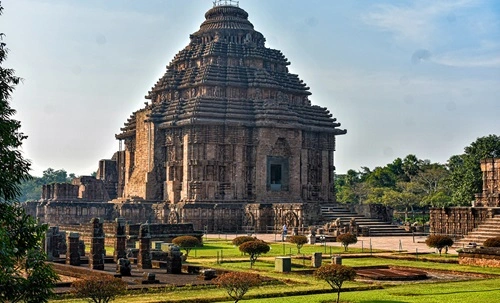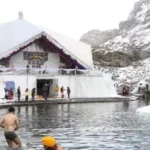The Konark Sun Temple, a UNESCO World Heritage site, stands as one of India’s most awe-inspiring monuments, showcasing the grandeur of ancient Indian architecture and culture. Located in the coastal town of Konark in Odisha, this 13th-century temple is dedicated to the Sun God, Surya. Designed in the shape of a colossal chariot with twelve pairs of intricately carved wheels and seven horses, the temple embodies both artistry and spiritual devotion. The Konark Sun Temple is not only a pilgrimage site for Hindus but also a symbol of India’s rich heritage, drawing history enthusiasts, architecture lovers, and photographers from around the world.
Choosing the best time to visit the Konark Sun Temple enhances the experience, allowing visitors to appreciate the temple’s beauty amidst pleasant weather and the lively atmosphere during local festivals. Here’s a guide to help you plan your trip to this architectural marvel, making the most of each season.

Discovering the Magnificence of Konark Sun Temple
The Konark Sun Temple, built by King Narasimhadeva I of the Eastern Ganga Dynasty in the 13th century, is a masterpiece of Kalinga architecture. The temple’s design represents a colossal chariot of the Sun God, symbolizing the journey of the Sun across the sky. The wheels, walls, and pillars are intricately carved with mythological stories, celestial beings, animals, and daily life scenes, showcasing an impressive level of detail and craftsmanship.
While a significant portion of the temple has been lost to time, the remaining structure still offers a glimpse into the architectural prowess of ancient India. The temple complex also features the iconic Natya Mandapa (dance hall), where dancers once performed in honor of the Sun God. Every corner of the Konark Sun Temple radiates history and artistic splendor, making it a must-visit for anyone exploring Odisha.
Best Seasons to Visit the Konark Sun Temple
1. Winter (November to February)
Winter is considered the best season to visit the Konark Sun Temple, as the weather is cool and comfortable, with temperatures ranging between 15°C and 25°C. The pleasant climate makes it ideal for exploring the temple complex without the discomfort of high temperatures or humidity. During winter, the temple’s sandstone structure appears particularly striking under the clear skies, and visitors can enjoy leisurely walks around the monument, soaking in the intricate details of the carvings.
One of the highlights of visiting Konark in winter is the Konark Dance Festival, held annually in December. This five-day festival celebrates Indian classical dance forms, including Odissi, Bharatanatyam, Kathak, Kuchipudi, and more, with the Sun Temple serving as a majestic backdrop. Renowned dancers from across the country perform against the illuminated temple, creating a mesmerizing experience that showcases India’s rich cultural heritage.
Winter is also the season for the International Sand Art Festival, held at Chandrabhaga Beach near the Sun Temple. Here, talented artists create elaborate sand sculptures, adding to the festive spirit and offering visitors a chance to witness unique art installations along the coastline. If you plan your visit around these events, you can immerse yourself in Odisha’s culture and art while enjoying the temple’s historical significance.
2. Summer (March to June)
Summer in Konark can be quite hot and humid, with temperatures often reaching 40°C. This makes the weather challenging for outdoor exploration, especially in the peak months of May and June. However, early mornings or late afternoons in March and April can still be manageable, allowing visitors to explore the Sun Temple during cooler hours.
Despite the heat, visiting Konark in summer has its advantages. Fewer tourists visit during this season, making it a quieter experience. The temple grounds are less crowded, allowing you to observe the intricate carvings and wander around the monument without interruptions. For photography enthusiasts, the soft light during sunrise and sunset in summer can create stunning images of the temple’s structure against a clear blue sky.
If you plan to visit in summer, make sure to carry water, wear light clothing, and use sun protection to stay comfortable. While this season may not be ideal for everyone, it offers a peaceful, uncrowded experience for those who prefer quieter explorations.
3. Monsoon (July to September)
The monsoon season brings moderate to heavy rainfall to Konark, transforming the surrounding landscape into a lush green paradise. Temperatures during the monsoon range from 25°C to 30°C, and while the rain can disrupt outdoor plans, it also adds a unique charm to the Sun Temple. The rain-washed structure glistens under the cloudy sky, and the cool, fresh air enhances the experience.
Monsoon is a great time to visit for nature lovers and photographers who appreciate the temple’s beauty in a more serene setting. The fewer tourists during this season allow for a quieter experience, perfect for introspection and enjoying the monument’s spiritual ambiance. However, visitors should be prepared for unpredictable weather and carry rain gear to navigate the temple complex comfortably.
The nearby Chandrabhaga Beach, located just 3 kilometers from the temple, is also a scenic spot during the monsoon. The beach comes alive with lush surroundings, and visitors can enjoy the coastal breeze and the dramatic waves crashing against the shore.
Key Attractions and Activities at Konark Sun Temple
- Exploring the Intricate Carvings: The Konark Sun Temple is known for its detailed carvings on the wheels, pillars, and walls. Each wheel functions as a sundial, and visitors can learn about how ancient people used these to tell time. The carvings depict deities, animals, and scenes from everyday life, reflecting the skill of artisans from the 13th century.
- Natya Mandapa: The temple’s dance hall, or Natya Mandapa, is a fascinating part of the complex where ancient dances were once performed in reverence to the Sun God. The mandapa’s pillars and walls feature carvings of dancers, musicians, and mythological figures, offering a glimpse into the cultural life of ancient Odisha.
- Konark Dance Festival: If you’re visiting in December, attending the Konark Dance Festival is a must. This cultural extravaganza celebrates classical Indian dance forms and attracts dancers and art lovers from across the country. The illuminated Sun Temple creates an enchanting backdrop for the performances, making the festival a memorable experience.
- Chandrabhaga Beach: Just a short distance from the Sun Temple, Chandrabhaga Beach is a pristine shoreline where visitors can relax and enjoy the scenic beauty. The beach is particularly stunning at sunrise, and the International Sand Art Festival, held here in December, adds to its appeal.
- Archaeological Museum, Konark: Located near the Sun Temple, the Archaeological Museum houses artifacts, sculptures, and carvings from the temple complex, offering insights into the temple’s history and significance. Visiting the museum can provide a deeper understanding of the architectural techniques and artistic heritage that make the Konark Sun Temple so special.
Practical Tips for Visiting Konark Sun Temple
- Entry Timings and Fees: The Konark Sun Temple is open from sunrise to sunset. There is an entry fee for Indian and foreign visitors, and tickets can be purchased on-site or online. Arriving early in the morning allows you to explore the temple in a quieter setting.
- Best Time of Day for Photography: The golden hours of sunrise and sunset offer the best lighting for photography, as the temple’s sandstone structure takes on a warm glow. The morning light, in particular, highlights the intricate carvings beautifully.
- Clothing and Footwear: Comfortable clothing and footwear are recommended, especially if you’re planning to explore the temple complex and nearby attractions. Since Konark is a spiritual site, dressing modestly is appreciated.
- Accommodation Options: While Konark has a few accommodations, nearby Puri (35 kilometers away) offers a wider range of hotels and guesthouses, making it a convenient base for day trips to the temple.
- Local Cuisine: Don’t miss the opportunity to try Odisha’s traditional dishes like chhena poda, a baked cottage cheese dessert, and dalma, a lentil-based curry with vegetables. The local food stalls and restaurants in Konark and Puri offer authentic flavors of the region.
Conclusion
The Konark Sun Temple is a timeless symbol of India’s rich cultural heritage and architectural genius. From the vibrant winters with cultural festivals to the lush monsoon backdrop, each season offers a unique way to experience this magnificent monument. Whether you’re drawn to the historical significance, the intricate artistry, or the cultural vibrancy of the Konark Dance Festival, a visit to this ancient temple will leave you with unforgettable memories. Plan your trip to coincide with your preferred season, and let the Konark Sun Temple’s majestic presence and spiritual ambiance transport you back to the golden era of Indian architecture.


